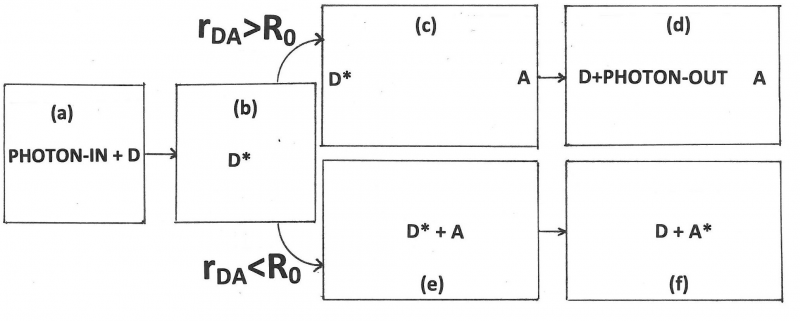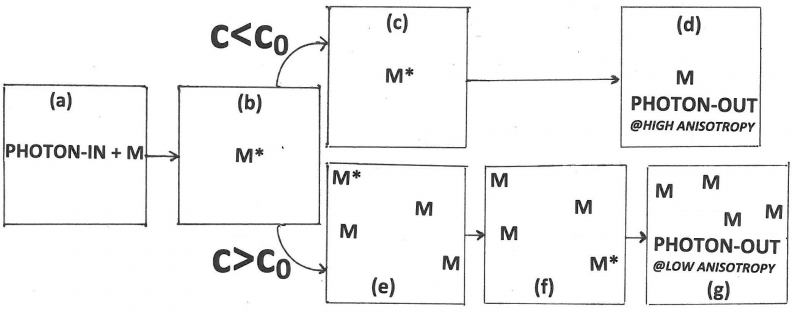FRET
http://photobiology.info/PDF/History%20of%20FRET.pdf
https://link.springer.com/article/10.1140%2Fepjh%2Fe2013-40007-9
by Dr. B. Wieb VanDerMeer, Department of Physics and Astronomy, Western Kentucky University, Bowling Green, KY 42101-1077, USA.
FRET is Fluorescence with Resonance Energy Transfer, or Fluorescence-detected Resonance Energy Transfer, or Förster Resonance Energy Transfer. It is an absorption of electromagnetic radiation by one molecule, the “donor,” followed by resonance interaction with another molecule, the “acceptor.” As a result, energy is transferred from donor to acceptor. The two molecules can be different or identical. If the two molecules are different, the process is called “hetero-transfer” (illustrated in Figure 1). If the two are identical we speak of “homo-transfer” (illustrated in Figure 2) and the energy can go back and forth for a while or go to yet another molecule until emission or a radiation-less transition takes place. FRET is extremely sensitive to the distance between the interacting molecules and can be used to visualize interactions and to measure distances between 1 and 10 nanometers.

Figure 1. Schematic representation of the various processes taking place during hetero-transfer. In (a) a photon with frequency matching the excitation spectrum of a donor (“photon-in”) and a donor are shown just before excitation, (b) after the photon is absorbed the donor is in an excited state and two possible pathways are available. If the separation distance,
[math]r_{DA}[/math], is bigger than the Förster distance,
[math]R_{0}[/math], the pathway (c)-to-(d) is dominant: the donor stays excited for a few nanosecond (c), and then, (d), emits a fluorescent photon (“photon-out”). If
[math]r_{DA}[/math] is smaller than
[math]R_{0}[/math], the pathway (e)-to-(f) is dominant. The donor will resonate with an acceptor (e). FRET takes place and energy is transferred to the acceptor (f). If the acceptor is fluorescent the acceptor may emit (sensitized emission, not shown).

Figure 2. Schematic representation of the various processes taking place during homo-transfer. The donor and acceptor are of the same species, indicated here as M. If the concentration is smaller than the critical concentration,
[math]c\lt c_{0}[/math] , the pathway (c)-to-(d) is dominant: the molecule stays excited for a few nanosecond (c), and then, (d), emits a fluorescent photon at a frequency lower that that of the incoming photon as some vibrational energy is lost (“internal conversion” related to the Stokes’ shift). If the concentration is higher than the critical concentration,
[math]c\gt c_{0}[/math], the pathway (e)-(f)-(g) is dominant. The excited moleculemay resonate with other molecules in the ground state, and the excitation energy may hop from one to another. Soon one of these, possibly the original, emits a fluorescent photon (g). The overall anisotropy of the fluorescence is low.
FRET can be observed in different ways. A convenient method in the case of hetero-transfer is to examine the effect of FRET on spectra of donors and acceptors as illustrated in Figure 3.

Figure 3. Schematic illustration of donor and acceptor spectra, and their relation to FRET, which can occur only if there is overlap between the donor emission spectrum and the acceptor absorption spectrum.


